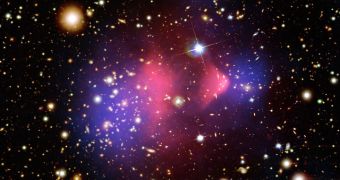DAMA, or the Dark Matter collaboration, has just finished its four-year second phase of its experiments and claims to have strong evidence of observing dark matter particles. The same Italian and Chinese collaboration claimed to have had clear evidence of dark matter existence ever since 2003, although other physicists believe the results to be only a statistical anomaly.
"We are pretty sure now that this signal is not a statistical fluke. What it means is another matter," said astroparticle physicist at the University of Wisconsin-Madison, Francis Halzen.
Invisible matter
Dark matter and dark energy are believed to make up to 96 percent of the whole mass of the universe, however it has never been directly observed nor identified as to what type of particles this matter may contain. All we know is that there is an invisible something responsible for the extra gravitational pull between stars and galaxies.
The DAMA experiment is located under 1.4 kilometers of rock, deep beneath the Gran Sasso mountain in Italy. Dark matter particles are supposed to tunnel all the way through the mass of rock and hit a sodium iodide detector, which emits photons of light in the process. Most of the photon emissions are determined by natural radioactivity, in the form of neutron particle emissions, however some may also be created by the interactions between dark matter particles and ordinary fundamental particles.
Dark matter signals can be filtered out by considering variables such as the speed of the Earth as it orbits the galaxy and the planet's orbital trajectory in relation to the Milky Way. If predictions are correct, then during the month of June, dark matter particle numbers should increase as the Earth follows the Sun while traveling through the galaxy, with a minimum of dark matter particles during the month of December, when the planet moves in the opposite direction.
Criticism
The first phase of the DAMA experiment ran for a period of seven years, with the help of a 100-kilogram detector claimed to have obtained similar results, however other experiments cannot find anything. The second phase of the experiment used a 250-kilogram detector, and confirmed the dark matter particles variation in relation to the Earth's location on orbit around the Sun.
According to the team participating in the experiment, there is an extremely low change that the dark matter particles signal in just a random fluctuation, some in the range of one in several billion. "The discussion about whether this is some unknown systematic effect remains," says Halzen.
"Right now, it is very difficult to reconcile theoretically what they are seeing and what we are seeing," says Richard Gaitskell from Brown University, part of the investigation team of two separate dark matter experiments, the Xenon project and the Cryogenic Dark Matter Search. "The issue of dark matter is important enough that we should pay attention to this; we should not just ignore it," concluded Halzen.

 14 DAY TRIAL //
14 DAY TRIAL //